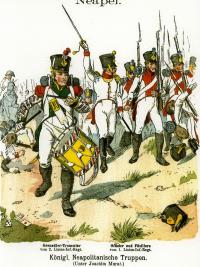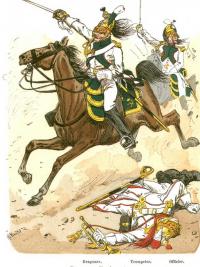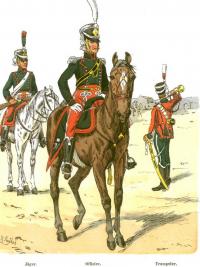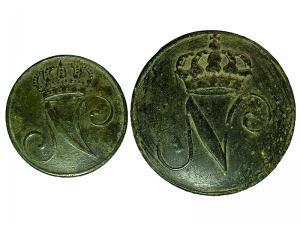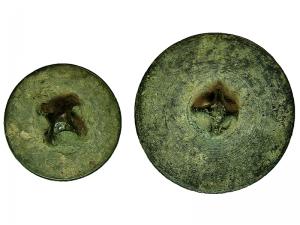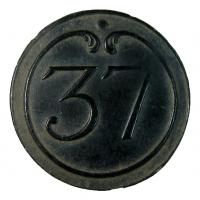Неаполитанское Королевство - Kingdom of Naples
Неаполитанское Королевство.
Войска Неаполитанского королевства Бурбонов в период наполеоновских войн считались чуть ли не самыми худшими в Европе. Неаполитанский король был известен своим безволием, а все внимание королевы было сосредоточено на плотских утехах. Престиж военной службы среди подданных королевства был на нуле. Армия набиралась в основном из люмпенезированных слоев населения - воров, грабителей, убийц, в лучшем случае из авантюристов и прочего отребья.
Как при короле Жозефе, так и при короле Жоакино нормой считалось проводить набор солдат в тюрьмах.
Однако реформы армии, начатые королем Жозефом и продолженные Мюратом, медленно но верно давали результаты. Для реформирования в вооруженных силах на помощь были призваны опытные французские военные чиновники, которые привнесли в армию кодекс Наполеона.
Большой проблемой для королевства была коррупция. То есть, разбойники и прочий криминалитет были прочно и глубоко связанны с местной знатью, поэтому противодействие проводимым реформам проводилось как “сверху”, так и “снизу”.
Однако к 1809 году после того как для борьбы с “бандформированиями” были привлечены регулярные войска. В результате этой акции были полностью разгромлено несколько крупных банд. Престиж государственной власти среди местного населения значительно укрепился.
Однако очередной призыв в армию для укрепления ее мощи и увеличения численности свел на нет все достигнутые результаты. Численность и количество банд снова увеличилась. На этот раз за счёт дезертиров и тех кто решил скрыться от призыва.
Положение усугублялось тем, что Бурбоны и англичане обосновавшиеся на Сицилии противостояли режиму Иоахима Мюрата. Поэтому они поддерживали и вооружали наиболее крупные разбойничьи отряды.
К 1811 году некоторые области Неаполитанского королевства были как бы сами по себе, они не подчинялись правительству и на
Этой территории не действовали никакие законы кроме закона силы.
Порядок в войсках смог навести только маршал Сюше. После того как под его начало перешли полки Неаполитанского королевства в частях был наведен относительный порядок. Солдаты были обеспечены всем необходимым. Большое внимание было уделено обучению войск, следовательно укрепилась дисциплина солдат.
Неаполитанское королевство было одним из самых крупных на Апеннинском полуострове. Воспользовавшись победой над Третьей коалицией под Аустерлицем и, как следствие этой победы, ослаблением влияния Австрии в Германии и Северной Италии, Наполеон выгнал неаполитанских Бурбонов с полуострова.
Бразды правления королевством Наполеон передал своему брату Жозефу, который был коронован 30 марта 1806 года. Однако правление его было недолгим. Через два года он отрёкся от неаполитанского престола и получил из рук Императора корону Испании.
Неаполитанский престол Наполеон передал своему шурину - командиру всей кавалерии Великой Армии - Иоахиму Мюрату.
"Король Жоакино" (как его стали звать в Неаполитанском королевстве) оправдал надежды и ожидания Наполеона. Части подчинённые Мюрату несли службу и выполняли поставленные задачи практически везде, где этого требовал от них Император. От Испании до заснеженной России и Германии - служили солдаты Неаполитанского королевства, защищая в основном интересы Франции, а не своего государства.
Армия Неаполитанского королевства в составе Великой Армии в основном осуществляла охранные и гарнизонные обязанности на Апенинском полуострове где в то время располагалось несколько итальянских государств. Всего несколько частей неаполитанцев находились вне Италии. Среди них:
Первый полк линейной пехоты в послужном списке которого участие в следующих кампаниях:
- штурм Матаро - 17 июня 1808 года.
- неудачный штурм Жироны 20 июня 1808 года.
- неудачная осада Жироны 24 июля-16 августа 1808 года.
- взятие Жероны 6 июня - 10 декабря 1809 года.
- осада и взятие Тартоссы 16 деаебря 1810 года - 2 января 1811года.
Второй полк линейной пехоты учавствовавший в следующих стычках и сражениях:
- Молинс дель рей 21 декабря 1808 года.
- взятие Жироны июня 10 декабря 1809 года.
- осада и взятие Тартоссы 16 декабря 1810 года - 2 января 1811года.
Первый полк лёгкой пехоты:
- осада и взятие Тартоссы 16 декабря 1810 года - 2 января 1811года.
Второй полк конных егерей, он участвовал в следующих акциях:.
- неудачная осада Жироны 24 июля-16 августа 1808 года.
- осада и взятие Тартоссы 16 деаебря 1810 года - 2 января 1811года.
К 1811 году всё,что осталось от двух пехотных полков в Неаполе переформировали в 8-й линейный полк. Первый и второй полки были развёрнуты заново, за счёт дополнительных рекрутов и посылки к ним запасных батальонов.
Гвардия неаполитанского королевства в своём составе имела:
-- Пешие гренадеры Королевской гвардии: 1 полк двухбатальонного состава. Всего 1150 человек. В батальоне 4 роты по 140 человек.
-- Велиты Королевской гвардии: 2 полка по 1150 человек двухбатльонного состава, в батальоне 4 роты по 140 человек в каждой.
-- Моряки Королевской гвардии,- 1 батальон из двух по 140 человек.
-- Почётная гвардия, - 1 эскадрон - 190 человек, две роты по 95 человек.
-- Конные велиты Королевской гвардии, - 1 полк около 390 человек, состоящий из двух эскадронов по 190 человек в каждом. В эскадроне 2 роты по 95 человек.
-- Гвардейская артиллерия,- по одной роте пешей и конной артиллерии. В пешей артиллерийской роте,- шесть восьмифунтовых пушек и 2 гаубицы. В конной роте - четыре четырёхфунтовые пушки и две гаубицы.
К 1812 году армейские части располагали восемью полками линейной пехоты. В каждом полку 3 полевых и 1 запасной батальон. Полевой батальон состоял из шести рот. Запасной,- из 4-х фузилёрных рот.
Количество человек в полку линейной пехоты определялось в 3200. В полевом батальоне - 850 человек. В каждый полевой батальон входили одна гренадерская, одна вольтижерская и 4 фузилерные роты по 140 человек в каждой.
27 апреля 1812 года для участия в Русском походе из всего состава войск Неаполитанского королевства была организована неаполитанская дивизия.
7 июля 1812 года она получила название Тридцать третьей (неаполитанской) дивизии Великой Армии. Командование над дивизией принял дивизионный генерал Франсуа Детре. Она была определена в Одиннадцатый корпус которым командовал маршал Ожеро.
Состав дивизии:
Первая бригада бригадного генерала Джузеппе Россароля.
---------------------------------------------------------------------------------------
-- 5-й линейный пехотный полк "Королевская Калабрия" - Calabria- 1-й и 2-й батальоны полка, в строю 49 офицеров и 1594 нижних чина. Командир полка полковник Лебон.
-- 6-й линейный пехотный полк "Неаполь" - Napoli - 1-й и 2-й батальоны полка, в строю 42 офицера и 1564 нижних чина. Командир полка полковник Карло Филанджиери.
-- Моряки Королевской Гвардии - 1-й и 2-й роты, в строю 8 офицеров и 176 нижних чинов. Командовал полковник Капечелатро.
Вторая бригада бригадного генерала Анджелло Д’Амброзио.
-----------------------------------------------------------------------------------------
-- 7-й линейный пехотный полк "Королевский африканский" - Real Afrika его называли так до 1811 года, а после переименовали в "Принц Люсьен",- 1-й и 2-й батальоны полка, в строю 41 офицер и 1475 нижних чинов. Командир полка полковник Макдональд.
-- Велиты Королевской гвардии - 1-й и 2-й батальоны, в строю 46 офицеров и 1475 нижних чинов. Командир полковник Ла Рокка.
Дивизионная кавалерия.
------------------------------------
-- Почётная Королевская гвардия,- 1-й, 2-й и 3-й эскадроны. В строю 31 офицер и 395 нижних чинов. Командир полковник ди Кампан.
-- Конные велиты королевской Гвардии, - 1-й и 2-й эскадроны, в строю 22 офицера и 320 нижних чинов.
-- Рота конной артиллерии - 6 орудий, в строю 6 офицеров и 75 нижних чинов.
Тридцать третья (неаполитанская) дивизия по регламенту находилась на охране коммуникационной линии Великой Армии. Это подтверждается находками пуговиц и отдельных частей амуниции принадлежащей к неаполитанским частям. Основная часть находок приходится на участок дороги от Сморгони до Ошмян и дальше на Вильно. Это обусловлено тем, что до Сморгони дошла часть дивизии генерала Луазона, основную часть которой составляли неаполитанские пехотные полки.
Практически все потери личного состава были связаны с суровой погодой. Дневные температуры во время перехода опускались до 28-33 градусов ниже ноля.
Молодые солдаты не привыкшие к столь экстремальному холоду быстро замерзали в пути.
На биваках неаполитанцев оставались десятки, а то и сотни замёрзших солдат и офицеров. По воспоминаниям очевидцев тех событий весь путь отступления был просто усеян трупами солдат неаполитанской дивизии.
В конце трагического отступления, 6 декабря 1812 года, когда Наполеон уже оставил остатки своей армии в Сморгони и уехал в Париж собирать новых солдат, его эскорт состоял из Почётной Королевской Гвардии Неаполитанского королевства. Командовал эскортом начальник штаба 33-й дивизии Марешаль де Кан Флорестано Пепе. Пока Наполеон добрался до Медников от сопровождавшего его эскорта практически ничего не осталось. Почти все кавалеристы остались на дороге замёрзшие или умирающие от холода.
В Медниках Императора ждали другие неаполитанские кавалеристы под командованием герцога Рокка-Романа. Эти солдаты в количестве от 50-ти до 100 человек сопровождали Наполеона до Вильни. От отряда за ночь проведенную в пути не осталось почти никого. В Вильню с Императором смогли доехать только 8 человек.
Температура ночью опустилась до -35 градусов по Цельсию.
Число солдат в дивизии генерала Луазона при выходе из Вильно доходило до 12000 человек. Во Францию вернулось не более 360 человек. Эти данные взяты из рапортов офицеров дивизии. Большую часть этой дивизии составляли войска Неаполитанского королевства.
После поражения в Русской Компании неаполитанские войска сражались под Лютценом 2-го мая 1813 года и при Лейпциге 16-19 октября 1813 года в составе XI корпуса. Подразделения фузилёрных рот 5-го, 6-го и 7-го полков несли гарнизонную службу в Дрездене и Ланциге в период осады этих городов русскими войсками.
Kingdom of Naples.
The Troops of the Bourbon Kingdom of Naples were considered as almost the worst troops in Europe during the Napoleonic wars. The King of Naples was known for his lack of will, and all the attention of the Queen was focused on the carnal pleasures. The prestige of the military service among the lieges of the kingdom was at zero. The army recruited mainly from lyumpenezirovannyh segments of the population – the thieves, the robbers, the murderers, and at the best opportunity, of adventurers and other scum.
As with the King Joseph, with the King Joaquim the norm was to take people from prisons as the soldiers.
However, the reforms of the army that were initiated by the King Joseph and continued by Murat, slowly but surely produced the results. To reform the armed forces there were called the French military officials for helping. And they brought the army the Napoleonic Code.
The big problem for the Kingdom was the corruption. That is, robbers and other criminals were firmly and deeply connected with the local nobility, so the opposition to the reforms was carried out in a "top" and in a "bottom".
However, by 1809 after the fight against "armed gangs" there were involved the regular army. As a result of this action several large gangs were completely destroyed. The prestige of the state power among the local population had been increasing.
However, the next conscription to strengthen the power of the army and to increase the number of people there brought to naught the results. The number and the quantity of the bands increased again. At that time it happened due to the deserters and those who decided to escape the draft.
The situation was aggravated by the fact that the Bourbons and the English who had settled in Sicily opposed the regime of Joachim Murat. Therefore, they had supported and armed the largest robber’s groups.
By 1811 some areas of the Kingdom of Naples were by themselves, they did not obey the government. There weren’t operated any laws except the law of the force.
Only Marshal Suchet imposed the order in the armies. After the regiments of the Kingdom of Naples became under there appeared the comparative order in military units. The soldiers were provided with everything necessary. Much attention had been paid to the training of the troops, thus discipline of the soldiers were strengthened.
The Kingdom of Naples was one of the largest in the Apennine peninsula. Taking the advantage of the victory over the Third Coalition of Austerlitz and the weakening of the influence of Austria on Germany and northern Italy that was a result of this victory, Napoleon drove out the Neapolitan Bourbons from the peninsula.
Napoleon gave the Kingdom to his brother Joseph, who was crowned on March 30th, 1806. However, his direction was short-lived. Two years later, he cut off from the throne of Naples, and received the crown from the hands of the Emperor of Spain.
Napoleon gave the Neapolitan throne to his brother in law- the commander of the Grand Army of the entire cavalry - Joachim Murat.
"The King of the Joaquim" (as he was called in the Kingdom of Naples) justified the hopes and expectations of Napoleon. The parts that had been under his command had served and performed anywhere the Emperor wanted. From Spain to snowy Russia and Germany there were the soldiers of the Army of the Kingdom of Naples. They mainly provided the security and garrison duties on Apeninsky peninsula, where at that time were several Italian states. Only a few parts of the Neapolitans were outside Italy. Among them there were:
The first line infantry regiment, which participated in the following campaigns:
- The Assault of Mataro - June 17th, 1808.
- The Unsuccessful assault Girona June 20th, 1808.
- The unsuccessful siege of Girona - since July 24th to August 16th, 1808.
- The Taking of Gerona - June 6th - December 10th, 1809.
- The siege and capture of Tartossa December 16th, 1810 - January 2nd, 1811.
The second line infantry regiment, which participated in the following battles and skirmishes:
- The Molins del Rey - December 21st, 1808.
- The Taking of Girona - December 10th, 1809.
- The siege and capture of Tartossy - since December 16th, 1810 - January 2nd, 1811.
The first light infantry regiment:
- The siege and capture of Tartossy – since December 16th, 1810 - January 2nd, 1811.
The second regiment of mounted rangers, that participated in the following actions:
- The unsuccessful siege of Girona – since July 24th till August 16th, 1808.
- The siege and capture of Tartossy – since December 16th, 1810 - January 2nd, 1811.
By 1811 all that remained of the two infantry regiments in Naples was reformed in the 8th line regiment. The first and second regiments were deployed again, at the expense of additional recruits and sending from the reserve battalions.
The Guard of the Kingdom of Naples had in its composition:
- The Hiking Grenadiers of the Royal Guard: 1 Regiment of doublebattalion’s composition. There were only 1,150 people. In the battalion there were 4 companies with 140 people in each.
- The Velits of the Royal Guard: 2 regiments of doublebattalion’s composition with only 1,150 people in it. In the battalion there were 4 companies with 140 people in each.
- The Sailors of the Royal Guard - 1 battalion of two with 140 people it.
- The Honorary Guard - 1 Squadron - 190 people, two companies with 95 people in each.
- The Horse Velits of the Royal Guard - 1 regiment with about 390 people in it, consisting of two squadrons with 190 men in each. In squadron there were 2 companies with 95 people in each.
- The Guards Artillery - one company of walking and horse artillery. In the walking artillery company there were six eight-foot guns and 2 howitzers. In the company of a horse there were four-foot guns and two howitzers.
By 1812, the army units had eight regiments of infantry of the line. Each regimen 3 field and 1 spare battalion. The field battalion consisted of six companies. The spare was made of 4 fusiliers’ companies.
The number of people in the Line Infantry Regiment was determined as 3200. In the field battalion there were 850 people. In each field there included one battalion of Grenadier, one Voltigeurs’ and 4 Fusiliers’ companies with 140 people in each.
On April 27th, 1812 there was organized the Neapolitan division of all the members of the troops of the Kingdom of Naples to participate in the Russian campaign.
On July 7th, 1812 it was named as the thirty-third (Neapolitan) division of the Grand Army. The division took over the commands of Major-General Francois Détré. It had been defined in the Eleventh Corps that was commanded by Marshal Augereau.
The composition of the division:
The first First Brigade of Brigadier General Giuseppe Rossarol.
-------------------------------------------------- -------------------------------------
- The 5th line infantry regiment "Royal Calabria" - Calabria- the 1st and the 2nd battalions of the regiment. In the ranks there were 49 officers and 1594 established men. Colonel Le Bon was the regimental commander.
- The 6th Line Infantry Regiment "Naples" - Napoli – the 1st and the 2nd battalions of the regiment. In the ranks there were 42 officers and 1564 established men. Colonel Carlo Filandzhieri was the regimental commander.
- The Sailors of the Royal Guard – the 1st and the 2nd companies. In the ranks there were 8 officers and 176 established men. It was commanded by Colonel Kapechelatro.
The Second Brigade, Brigadier General Angelo D'Ambrosio.
-------------------------------------------------- ---------------------------------------
- the 7th Line Infantry Regiment "Royal African" - Real Afrika had been called like that till 1811, and then was renamed into "Prince Lucien," - the 1st and the 2nd battalions of the regiment. In the ranks there were 41 officers and 1475 established men. Colonel MacDonald was the regimental commander.
- the Orders of the Royal Guard – the 1st and the 2nd battalions. In service there were 46 officers and 1475 established men. Colonel La Rocca was the commander.
The Divisional cavalry.
------------------------------------
- the Honorary Royal Guard – the 1st, the 2nd and the 3rd squadrons. In the ranks there were 31 officers and 395 established men. Colonel de Campan was the commander.
- the Horse Velits of the Royal Guard – the 1st and the 2nd squadrons, in the ranks there were 22 officers and 320 established men.
- the Horse Artillery company had 6 guns. In the ranks there were 6 officers and 75 established men.
The thirty-third (Neapolitan) division was on guard of the communication line of the Great Army. It is confirmed by findings of the buttons and the parts of the ammunition belonging to the Neapolitan parts. The main part of the findings goes to the stretch of the road from Smorgon to Oshmyany continue to Vilna. This is due to the fact that a part of the division of General Loison most of whom were Neapolitan infantry regiments reached Smorgon.
Virtually all the personnel losses were associated with severe weather. The daytime temperatures dropped to 28-33 degrees below zero during the transition. Young soldiers were not accustomed to such extreme cold and quickly frizzed on the road.
On the Bivouacs there were dozens or even hundreds of frozen soldiers and officers of the Neapolitan Army. According to eyewitnesses of the events all the way of retreat was just littered with the corpses of soldiers of the Neapolitan division.
At the end of the tragic retreat on December 6th, 1812, when Napoleon left the remnants of his army in Smorgon and went to Paris to collect new soldiers, his escort consisted of the Royal Guard of Honour of the Kingdom of Naples. The escort was commanded by the chief of staff of the 33rd Division Marechal de Caen Florestan Pepe. While Napoleon reached Mednikov there almost nothing left from the escort accompanying him. Almost all of the cavalry were frozen on the road or dying from the cold. In Medniki the Emperor waited for other Neapolitan cavalry under the command of the Duke Rocca Romana. These soldiers were in the range of 50 to 100 people who accompanied Napoleon to Villeneuve. There was almost no one after the night that was spent in the road. Only 8 people reached Vilna together with the Emperor. The night temperature dropped to -35 degrees.
The number of soldiers in the Division of General Loison reached 12,000 people when they went out from Vilna. No more than 360 people returned to France. This information is taken from the reports of the officers of the division. The biggest part of this division was the troops of the Kingdom of Naples.
After the defeat in the Russian Campaign the Neapolitan troops fought at Lutzen on May 2nd, 1813 and at Leipzig on October 16-19, 1813 as a part of XI Corps. The division of Fusiliers’ companies of the 5th, the 6th and the 7th regiments carried the garrison duty in Dresden and in Lantsige during the siege of the city by the Russian troops.
Неаполитанское Королевство.
Неаполитанское Королевство.
Неаполитанское Королевство.
Неаполитанское Королевство.
Social



